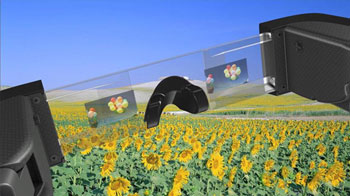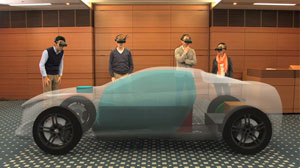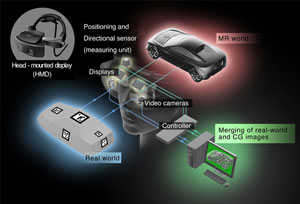Web Japan > Trends in Japan > Tech & Life > Evolution of Head-Mounted Displays
Evolution of Head-Mounted Displays
More and more advanced head-mounted displays (HMD) are coming out in Japan. Worn like a pair of goggles, an HMD shows spectacular video images right in front of the wearer's eyes. One after another, Japanese manufacturers have developed HMD video entertainment systems with breathtaking 3D capabilities. These systems put together high-definition, flat-panel display technology and computer graphics (CG), both areas in which Japan excels. The manufacturers are now offering a whole new spectrum of video displays, ranging from a home theater system with a virtual wide screen – equivalent in size to that of a commercial movie theater – to various industrial applications.
Big-Screen Entertainment at Home

A head-mounted display (HMD) worn over the eyes offers private showing of video at home. Consumers can stay at home and enjoy a movie on an overwhelming virtual wide screen equivalent in screen size to a 750-inch screen. © SONY
The HMD has two image panels in the shape of a pair of glasses, one panel right in front of each eye, showing videos – movies, games and other content – on them. Despite its small size, the HMD is free from the confines of the real world and capable of showing videos on a huge screen, albeit a virtual one. The HMD technology was developed more than a decade ago, but it was only recently that 3D video software became abundantly available, prompting hardware manufacturers to develop new HMD systems one after another.
Home theater systems with large screens are already available, but they require a bulky projector, a full-size TV set and multiple speakers. They occupy considerable floor space and need cumbersome wiring.
An HMD system, which a Japanese manufacturer launched in November 2011, features spectacular video footage on a virtual display with the screen size equivalent to that of a 750-inch display. A viewer wearing the HMD has the feeling of sitting in front of a gigantic screen 9.3 meters high and 16.6 meters wide from a distance of about 20 meters or, in other words, sitting in a center seat of a large movie theater with a capacity for 500 people while actually sitting at home. The HMD has become more and more lightweight, with the headset of one new model weighing only 330 grams. With the space-saving feature, the HMD would be a handy gadget for anyone with space limitations, including students living on their own.
Moreover, the HMD employed organic light-emitting diodes (OLEDs) for display, which compare favorably with LCD systems in terms of brightness, contrast, persistence of vision and smoothness in image expression. Unlike the conventional display system showing 3D video images on a single panel for both eyes, the HMD shows different 3D videos on two panels – one for each eye. Thus the HMD has eliminated image crosstalk (ghosting) and made 3D videos much easier to watch.
Images Floating in Midair

"MOVERIO BT-100" realized a "see-through function" for the first time in the world. It simultaneously shows images of a prepared video and what is going on in front of the user's eyes. © EPSON
Enlarge photoWith more people carrying an iPad or another tablet PC brand to continue to enjoy a movie or Internet-distributed video on the go, some become overly preoccupied with whatever they are watching and may miss their station to get off.
There is an HMD system developed by another Japanese manufacturer to address just that problem. The HMD features a "see-through function" allowing the wearer to see not only videos, but also what is happening around him or her. In other words, the HMD user can see video shown on a screen floating in midair against the backdrop of real scenery.
It will eliminate HMD viewers' fear of being unable to see what is happening around them and make them feel safe while watching a video on the go, be it on the train or in a public space.
As its wearer changes the viewing angle, the HMD changes its screen size. For example, as the wearer looks 5 meters ahead, the virtual screen's size becomes the equivalent of an 80-inch screen, measuring about 1 meter high and about 1.7 meters wide. At 20 meters ahead, the virtual screen becomes the equivalent of a 320-inch screen or about 4.0 meters by about 7.1 meters, showing a movie on a huge screen floating against the dark night.
The HMD can connect with the Internet via Wi-Fi to view content without the aid of any other AV equipment. It can also receive digital broadcasts for mobile phones and replay movies stored in the memory card. With a headset and a controller at hand weighing just about 400 grams in total, the HMD can be used for mobile business purposes, including checking the latest news, in addition to entertainment.
The evolution of HMD systems for consumers is picking up the pace, making them even lighter, higher in image quality, less tiring to use, larger in screen size and more dynamic than tablet PCs or portable DVD players as well as greater in safety and easier to use.
HMD Finding Use in Industrial Design

An image of a Mixed Reality system that seamlessly mixes real and CG images of a car, giving viewers an impression that a car actually exists in front of them. © CANON
The HMD is also drawing increasing attention in Japan to new applications in automotive and other design and in engineering. For example, car designers normally have to make multiple life-size mockups with clay or synthetic resin to design a new car. With an HMD, however, they can project virtual 3D images of a car against the backdrop of a real environment. As the user changes viewing angles, virtual images can also be shown from different viewing angles. Real mockups cost a lot of money to produce, but an HMD mockup can be reproduced as many times as the designer would like by just changing colors or shapes in computer graphics, helping reduce mockup costs by a large margin.
The HMD system is built around "Mixed Reality" – image information-processing technology which seamlessly puts together and displays real and virtual images. The HMD captures real images with a pair of CCD cameras fitted on the eye parts of the HMD and combines them with separately prepared CG images as new 3D images. The 3D virtual image thus created will then be enlarged with a special prism into life-size images to be reviewed by the HMD wearer. It is a design method most fitting for designing large industrial products such as cars.
The HMD is fast becoming a must tool in Japan – a form of entertainment for consumers to enjoy movies at home with the sensation of a real movie theater and a useful tool for industrial design. As 3D image technology further evolves, more new applications will emerge on the horizon.
(October 2012)

